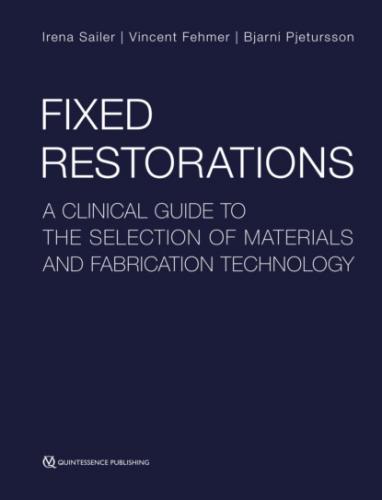Fixed Restorations. Irena Sailer
1.9.7 References
1.10 Fixation of implant-supported restorations
1.10.1 Introduction
1.10.2 Cemented implant restorations
1.10.3 Screw-retained implant restorations
1.10.4 Screw-retained versus cemented
1.10.5 Conclusions
1.10.6 References
1.11 The titanium-base abutment concept
1.11.1 Introduction
1.11.2 Traditional implant restorations supported by stock/customized abutments
1.11.3 Monolithic implant restorations supported by titanium-base abutments
1.11.4 Factors for predictable outcomes: adhesive cementation of monolithic ceramics to titanium-base abutments
1.11.5 Conclusions
1.11.6 References
1.12 Material selection flowcharts
Material selection for tooth-supported single-unit restorations
Material selection for tooth-supported multiple-unit restorations
Material selection for implant-supported restorations
1.13 Cementation flowcharts
Cementation flowchart for metal-ceramic restorations
Cementation flowchart for zirconia restorations
Adhesive cementation flowchart for lithium disilicate restorations
Adhesive cementation flowchart for feldspathic ceramic veneers
Cementation flowchart for posts
Cementation flowchart for extraoral cementation (eg, in laboratory)
Part II Clinical procedures step-by-step
2.1 Minimally invasive restorations (veneers)
2.1.1 Anterior regions: Additional veneers after trauma (two maxillary central incisors)
2.1.2 Anterior regions: Anterior veneer after trauma (single maxillary central incisor)
2.1.3 Anterior regions: Traditional veneers for restoration of amelogenesis imperfecta six maxillary anterior teeth)
2.1.4 Anterior & posterior regions: Traditional and palatal veneers after deep bite and orthodontic pretreatment (six maxillary anterior teeth)
2.1.5 Anterior & posterior regions: Traditional veneers after undetected celiac disease (10 veneers – maxillary premolar to premolar)
2.1.6 Anterior & posterior regions: Traditional veneers with the application of augmented reality (10 veneers – maxillary premolar to premolar)
2.1.7 Anterior & posterior regions: Traditional veneers with the application of augmented reality and orthodontic pretreatment (six maxillary anterior teeth)
2.1.8 Anterior & posterior regions: 360-degree and occlusal veneers with a single implant restoration (seven mandibular teeth and posterior implant)
2.1.9 Complex situations: Full-mouth rehabilitation with traditional veneers and overlays
2.1.10 Complex situations: Additional veneers and implant restorations (maxillary premolar to premolar)
2.2 Minimally invasive restorations (resin-bonded fixed dental prostheses [RBFDPs])
2.2.1 Anterior regions: Failing central incisor after many years of periodontal treatment
2.2.2 Anterior regions: Congenitally missing lateral incisor (RBFDP after orthodontic pretreatment)
2.2.3 Anterior regions: Congenitally missing lateral incisors (RBFDP after orthodontic pretreatment)
2.2.4 Anterior regions: Full-mouth rehabilitation with congenitally missing teeth (RBFDPs, veneers, and overlays after orthodontic treatment)
2.2.5 Complex situations: RBFDP and additional veneer in combination with orthodontic pretreatment
2.3 Defect-oriented restorations
2.3.1 Posterior regions: Defect-oriented partial crowns and overlay in posterior regions
2.3.2 Posterior regions: Defect-oriented overlays in posterior regions
2.3.3 Posterior regions: Defect-oriented restoration of endodontically treated posterior tooth
2.3.4 Posterior regions: Defect-oriented restorations (direct computer-aided composite build-up)
2.4 Conventional single crowns (SCs)
2.4.1 Anterior regions: Anterior SC with non-discolored abutment tooth
2.4.2 Anterior regions: Anterior SCs with discolored abutment teeth
2.4.3 Posterior regions: Posterior SC with non-discolored abutment tooth
2.4.4 Posterior regions: Posterior SC with a discolored abutment tooth
2.4.5 Complex situations: Conventional SCs and fixed dental prostheses (FDPs)
2.4.6 Complex situations: SCs in combination with an implant
2.5 Tooth-supported all-ceramic single crowns (SCs), fixed dental prostheses (FDPs), and a removable telescopic restoration
2.5.1 Anterior regions: Full-mouth rehabilitation
2.5.2 Posterior regions: Tooth-supported, all-ceramic three-unit fixed dental prosthesis (FDP)
2.5.3 Posterior regions: The 3D-printed prototype
2.6 Implant-supported single crowns (SCs)
2.6.1 Anterior regions: Anterior implant- supported SC with GBR
2.6.2 Anterior regions: Anterior implant- supported SC with GBR
2.6.3 Anterior regions: Anterior implant- supported SC
2.6.4 Posterior regions: Posterior implant- supported SC with GBR
2.6.5 Posterior regions: Posterior implant- supported SC with GBR
2.6.6 Posterior regions: Posterior implant- supported SC and optical impression
2.6.7 Complex situations: Tooth- and implant-supported all-ceramic SCs and fixed dental prostheses (FDPs)
2.7 Implant-supported restorations
2.7.1 Anterior regions: Implant-supported four-unit fixed dental prosthesis (FDP)
2.7.2 Posterior regions: Implant-supported three-unit fixed dental prosthesis (FDP)
2.7.3 Posterior regions: Implant-supported fixed dental prosthesis with mesial cantilever (FDP)
2.7.4 Posterior regions: Implant-supported fixed dental prostheses (FDPs)
2.7.5 Complex situations: Full-arch implant-supported fixed restoration with pink ceramics (FDP)
2.8 Maintenance
2.8.1 Intraoral direct repair of an existing restoration
2.8.2 Maintaining an existing restoration
2.8.3 CAD/CAM-fabricated Michigan
